
Rockingham County is a county located in the U.S. state of North Carolina. As of the 2020 census, the population was 91,096. Its county seat is Wentworth. The county is known as "North Carolina's North Star."
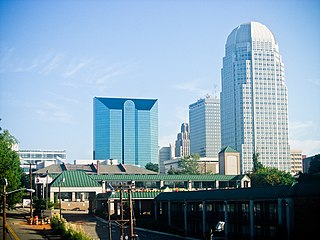
Winston-Salem is a city in and the county seat of Forsyth County, North Carolina, United States. In the 2020 census, the population was 249,545, making it the second-largest municipality in the Piedmont Triad region, the fifth-most populous city in North Carolina, the third-largest urban area in North Carolina, and the 90th-most populous city in the United States. With a metropolitan population of 675,966, it is the fourth-largest metropolitan area in North Carolina. Winston-Salem is home to the tallest office building in the region, 100 North Main Street, formerly known as the Wachovia Building and now known locally as the Wells Fargo Center.

Eden is a city in Rockingham County in the U.S. state of North Carolina and is part of the Greensboro-High Point Metropolitan Statistical Area of the Piedmont Triad metro region. As of the 2020 census, the population was 15,405. From the late nineteenth century through much of the 20th, the city was a center of textile mills and manufacturing. The city was incorporated in 1967 through the consolidation of three towns: Leaksville, Spray, and Draper.
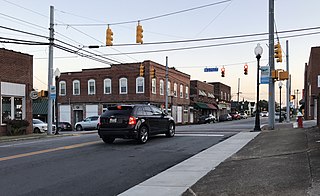
Mayodan is a town in Rockingham County, North Carolina, in the United States. It is a manufacturing site for Sturm, Ruger & Co., Bridgestone Aircraft Tire, and formerly General Tobacco. Washington Mills Company, later Tultex, operated a textile mill in Mayodan until 1999.
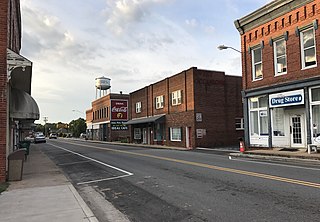
Stoneville is a town in Rockingham County, North Carolina, United States. Stoneville is part of the Greensboro–High Point metropolitan area of the Piedmont Triad. On March 20, 1998, an F-3 tornado touched down in neighboring Madison and Mayodan after the system had crossed into Rockingham County from Stokes County. Then, it strengthened into an F-3 as it crossed Route 220 as it followed the train tracks to downtown Stoneville.

The Piedmont Triad is a metropolitan region in the north-central part of the U.S. state of North Carolina anchored by three cities: Greensboro, Winston-Salem, and High Point. This close group of cities lies in the Piedmont geographical region of the United States and forms the basis of the Greensboro–Winston-Salem–High Point, NC Combined Statistical Area. As of 2012, the Piedmont Triad has an estimated population of 1,611,243 making it the 33rd largest combined statistical area in the United States.

U.S. Route 311 is a United States highway that runs for 62 mi (100 km) from Winston-Salem, North Carolina to near Danville, Virginia. It connects the cities of Winston-Salem, Madison, and Eden. The route runs northeast from Winston-Salem to Danville. By the numbering convention, it is an auxiliary route of US 11, however except for a brief period shortly after the route was established, it has not connected to its parent route.

Old Salem is a historic district of Winston-Salem, North Carolina, United States, which was originally settled by the Moravian community in 1766. It features a living-history museum which interprets the restored Moravian community. The non-profit organization began its work in 1950, although some private residents had restored buildings earlier. As the Old Salem Historic District, it was declared a National Historic Landmark (NHL) in 1966, and expanded in 2016. The district showcases the culture of the Moravian settlement in North Carolina during the 18th and 19th centuries, communal buildings, churches, houses and shops.
This article regards brewing in North Carolina.
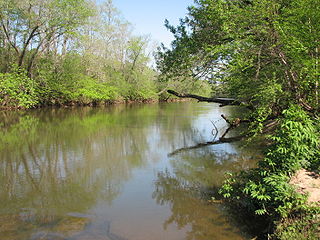
Mayo River State Park is a North Carolina state park in Rockingham County, North Carolina in the United States. It covers 2,778-acre (11.24 km2) along the Mayo River, and it adjoins a Virginia State Park of the same name. North Carolina's park is near Mayodan, North Carolina. The park is one of the newest in the North Carolina system, having been authorized by the General Assembly in May 2003.

Washington Mills-Mayodan Plant, also known as Mayo Mills, Washington Group-Mayodan Plant, and Tultex Corp.-Mayodan Plant, was a historic textile mill and national historic district located at Mayodan, Rockingham County, North Carolina. It encompassed four contributing buildings and two contributing structures in the town of Mayodan. The main spinning mill was built in 1895, and was a three-story, rectangular brick structure with a low-pitched gable roof. The mill was expanded several times between 1897 and 1954. It featured a four-story, one bay, tower with an open belfry at the top. Also on the property were the contributing knitting mill (1911), transformer house, railroad underpass, railroad spur, and frame wood shed. The mill closed in 1999.
The following is a timeline of the history of the city of Winston-Salem, North Carolina, USA.
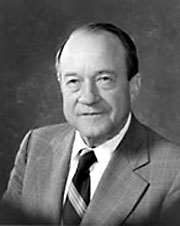
Dalton Larkin McMichael, Sr. was an American textile executive and philanthropist. He was ranked among the top fifty most influential textile executives in the twentieth century by Textile World Magazine. He was inducted into the Class of 2003 American Textile Hall of Fame by the American Textile History Museum.

Francis Henry Fries was an American textile businessman and industrialist from North Carolina.

James Jefferson Webster Sr. was an American businessman, farmer, and politician. He owned a dairy and tobacco farm, tobacco warehouses, a general store, and co-ran a car dealership in Rockingham County, North Carolina. A Democrat, Webster served as a Rockingham County commissioner for ten years. As a county commissioner, he played a role in the development of North Carolina Highway 135, which was posthumously named after him, and worked on the gubernatorial campaign of W. Kerr Scott.
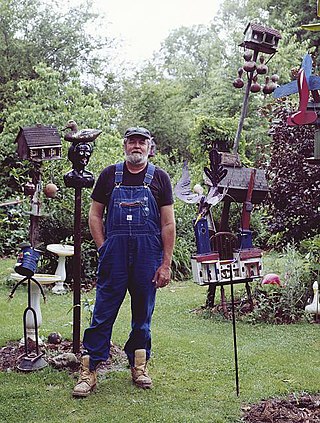
Binford Taylor Carter, Jr., known as Benny Carter or Bennie Carter, was an American contemporary visual artist. His primary focus was as a painter and sculptor within the genres of folk art and outsider art.
James Pratt Carter was an American military officer, politician, and educator. During his career in the United States Army, he served in World War II and the Korean War, retiring from the army in 1958 with the rank of lieutenant colonel. He was the mayor of Madison, North Carolina for twelve years and later served on the town's Board of Aldermen.

Linda Sue Carter Brinson is an American writer, journalist, and editor. She was the first woman assistant national editor at The Baltimore Sun and the first woman editorial page editor at the Winston-Salem Journal.

James Jefferson Webster III, also known as Jeff Webster, is an American competitive checkers player, musician, and retired postmaster. He was the National Youth Checkers Champion in 1981 and the World Youth Checkers Champion in 1982.

Elizabeth Webster Mitchell was an American educator and competitive shag dancer. In 1998 she won the National Shag Dance Championship in Myrtle Beach, South Carolina. Mitchell was killed during the 1998 Gainesville–Stoneville tornado outbreak a week after she won the championship. She was posthumously inducted into the Beach Shaggers National Hall of Fame's Keepers Of The Dance in 2002.




















